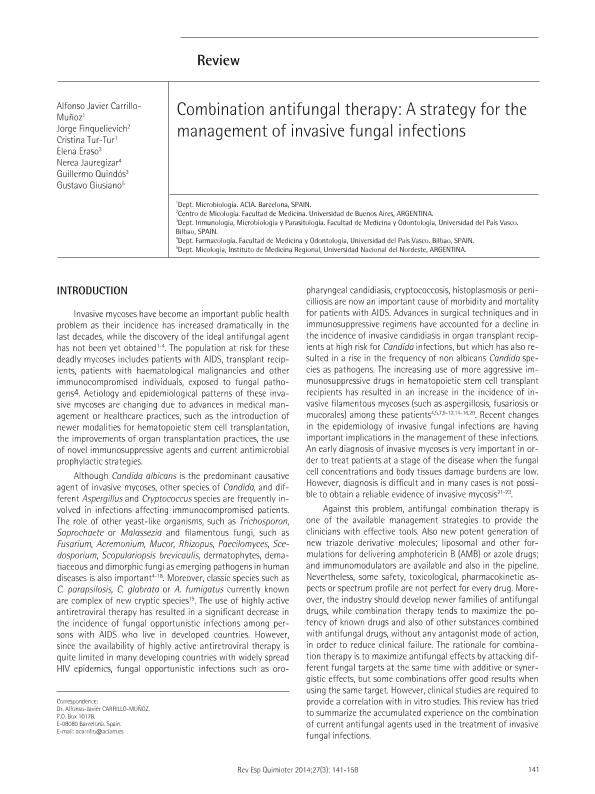Artículo
Combination antifungal therapy: A strategy for the management of invasive fungal infections
Carrillo Muñoz, A. J.; Finquelievich, Jorge; Tur Tur, Cristina; Eraso, Elena; Jaureguizar, Nerea; Quindós, Guillermo; Giusiano, Gustavo Emilio

Fecha de publicación:
09/2014
Editorial:
Grupo Ars Xxi Comunicacion S L
Revista:
Revista Espanola de Quimioterapia
ISSN:
0214-3429
Idioma:
Inglés
Tipo de recurso:
Artículo publicado
Clasificación temática:
Resumen
The lack of an ideal antifungal drug or completely successful agent, suggests that combination therapy may be an appropriate option for the management of fungal infections. In this review, different antifungal combination therapy approaches will be discussed. In brief, the rationale for combination therapy is to maximize antifungal effects by attacking different fungal targets at the same time. However, the scientific basis for this approach requires evidence from prospective clinical trials of antifungal combinations. It is possible that real advantages will be seen for particular combinations only in particular mycoses and/or particular types of patient. Combination tends to reduce clinical failure when resistant strains could be recovered from patients, although drug interactions and cross-resistance may result. Synergy has been established between conventional antifungal agents and also between investigational molecules. Alternatively, combination of fluconazole and cyclosporine results fungicidal for fluconazole-susceptible strains of Candida albicans. An overall enhanced susceptibility is reached in intrinsically resistant Candida when combination of azole antifungal drugs or terbinafine with calcineurin inhibitors is used. Azoles, such as voriconazole, itraconazole, and fluconazole are being tested in combination with other antifungal agents such as amphotericin B, caspofungin, or terbinafine and. In addition, amphotericin B is actually administered in combined therapy with caspofungin. The traditional combinations of amphotericin B plus 5-fluorocytosine or amphotericin B plus rifampicin have been replaced by these newer combinations. Other combinations such as caspofungin plus amphotericin B or voriconazole have also been synergic against clinical isolates of Aspergillus and Fusarium. This has been confirmed in animal models in the case of caspofungin plus itraconazole in the treatment of invasive pulmonary aspergillosis and caspofungin plus liposomal amphotericin B in the management of invasive aspergillosis.
Palabras clave:
Micosis Invasoras
,
Tratamiento
,
Combinaciones
,
Antifúngicos
Archivos asociados
Licencia
Identificadores
Colecciones
Articulos(CCT - NORDESTE)
Articulos de CTRO.CIENTIFICO TECNOL.CONICET - NORDESTE
Articulos de CTRO.CIENTIFICO TECNOL.CONICET - NORDESTE
Citación
Carrillo Muñoz, A. J.; Finquelievich, Jorge; Tur Tur, Cristina; Eraso, Elena; Jaureguizar, Nerea; et al.; Combination antifungal therapy: A strategy for the management of invasive fungal infections; Grupo Ars Xxi Comunicacion S L; Revista Espanola de Quimioterapia; 27; 3; 9-2014; 141-158
Compartir



